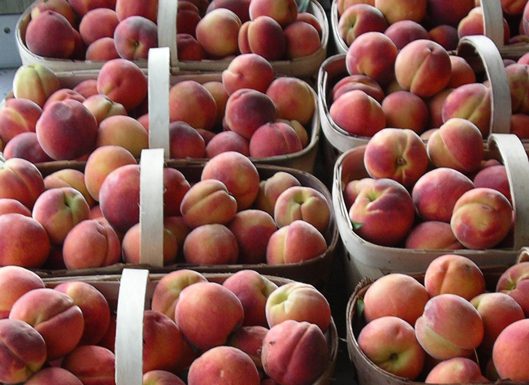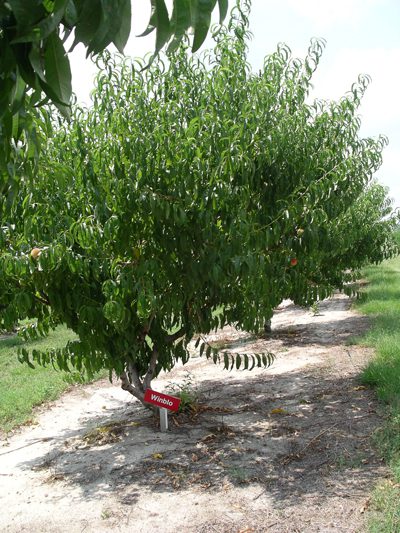The Sandhills’ peachy heritage

A peach display in the grocery store might mention where the fruit was grown. Too often, that means Georgia or California. At a farm stand in the Sandhills, the peaches come from an orchard right here on the edge of the Uwharries. Growers even note the specific variety. After writing about the Ophir apple last fall, I realized many of our local peach varieties are also named for communities in the region – Candor, Biscoe, Norman, Winblo, Ellerbe and Pekin.
They’re among the varieties developed at the Sandhills Research Station (SRS) in Windblow. (As SRS director Jeff Chandler wryly noted, the peach is spelled the way we say it.) The N.C. Department of Agriculture and N.C. State University sponsor 18 such stations across the state. They act as living laboratories for research on an array of agricultural crops. The SRS opened in 1940 and moved to its current 517-acre site in 1951. At that point, Franklin Correll and Carlyle Clayton began developing peach varieties that would perform well in the Sandhills. Many of those they produced – after nearly two decades of research – were named to honor communities long associated with peaches.
 Growers suffered major losses due to freeze in eight years during the 1980s, prompting SRS researcher Dennis Werner to develop varieties with a later bloom. As a result of his work, we now have Challenger, Contender, China Pearl, Intrepid, Carolina Gold and others. Today, the SRS continues to evaluate rootstocks and develop peaches with better yield and disease resistance. Peaches are susceptible to bacterial and fungal infections, so improved varieties can allow growers to use less pesticide. Many trees succumb to “peach tree short life” just as they mature enough to bear fruit. The cause seems to be some combination of weather conditions, a bacterial canker and nematodes in the soil, but the result is the same – trees either fail to leaf out or collapse and quickly die. Increasing their longevity helps growers realize a profit on their investment.
Growers suffered major losses due to freeze in eight years during the 1980s, prompting SRS researcher Dennis Werner to develop varieties with a later bloom. As a result of his work, we now have Challenger, Contender, China Pearl, Intrepid, Carolina Gold and others. Today, the SRS continues to evaluate rootstocks and develop peaches with better yield and disease resistance. Peaches are susceptible to bacterial and fungal infections, so improved varieties can allow growers to use less pesticide. Many trees succumb to “peach tree short life” just as they mature enough to bear fruit. The cause seems to be some combination of weather conditions, a bacterial canker and nematodes in the soil, but the result is the same – trees either fail to leaf out or collapse and quickly die. Increasing their longevity helps growers realize a profit on their investment.
Growers face daunting odds in bringing a profitable crop to market. I understand their desire to provide a continuous supply of fruit throughout the season and to try new varieties that might perform better, but I also hope they’ll maintain their selection of varieties named for our local communities. Since I predate some of my favorites by nearly a decade, I have a hard time thinking of them as “heirlooms.” Instead, I consider them “heritage” peaches. Their names tell a story about the history of this region.
In the early 1920s, peaches were touted as a good investment. Speculators quickly flooded the market. When the bubble burst after a few years, many farmers went out of business and couldn’t sell their land for pennies on the dollar. Katharine Ball Ripley’s memoir, Sand in My Shoes, is a fascinating account of that era, documenting the good years and bad (mostly bad) on their farm in Samarcand, in eastern Moore County. In my grandmother’s day, Elbertas and Georgia Belles were the go-to peaches for canning and freezing. Because of their popularity with our elders, they’ve acquired a certain mystique, but they were the only varieties available at the time. They’re progenitors of the newer (and dare I say improved?) varieties we now claim as our own. Candor highlights its historic connection with peaches by hosting the annual N.C. Peach Festival the third Saturday in July (July 16 this year).
Changes came to the local peach industry in the 1960s. The SRS began releasing varieties developed specifically for the Sandhills – Candor, Biscoe, Emery, Norman, Pekin, Troy and Whynot – and the growers restructured their business model. They stopped shipping their precious peaches long distances and concentrated on a regional market. This kept them from being subject to the whim of middlemen in places like New York, and it allowed them to pick their peaches at the height of ripeness. Those of us in the Uwharries have the luxury of buying this high-quality fruit directly from the source. Many people who live farther afield don’t consider a trip to the beach complete without a stop at a farm stand in the Sandhills. The crop is also sold at farmers markets in the region and in urban centers like Charlotte, Greensboro and Raleigh. For more information about where to find Sandhills peaches, visit http://www.ncfarmfresh.com/farms.asp.
With the incredible bounty at our fingertips, it surprises me that annual peach consumption in the U.S. is only 4 pounds per person. (I could conceivably eat that much on a single day in July.) The figure probably reflects the quality of what’s offered in grocery stores. Who can get excited about a peach that’s hard or mealy? Once people know what a real, tree-ripened peach tastes like, they’re usually unwilling to settle for anything else. Fortunately, growers in the Sandhills offer upwards of 50 varieties, so we can enjoy good peaches from late spring until early fall. Some have a tart edge and some have a mellow sweetness. Others have a flavor as heady as perfume. I’m partial to Norman and Winblo for their intense but balanced flavor, but I’m happy to sample other varieties throughout the season. Many growers provide lists with approximate ripening dates. I scan them each summer, waiting for my favorites. The anticipation is almost as delicious as a juicy Sandhills peach.
Click here for recipes to enjoy during peach season.
Photographs by Ruth Ann Grissom
To see a video about this subject, including interviews with researchers at the Sandhills Research Station click here.
Special thanks to Barbara Johnson of Johnson Peach Outlet and to Jeff Chandler and Mike Parker of the Sandhills Research Station (www.ncagr.gov/research/srs.htm) for taking time to help me with this article.